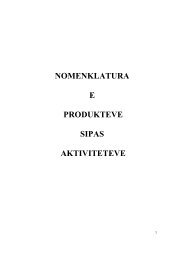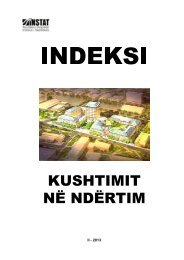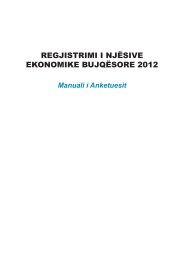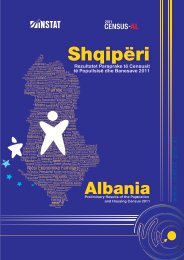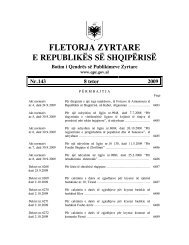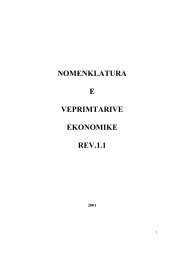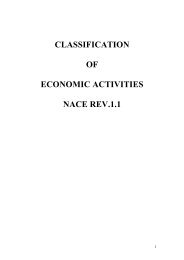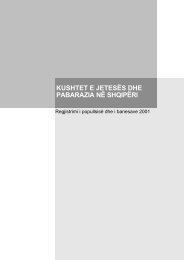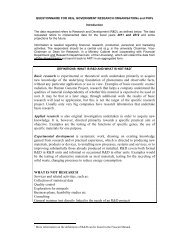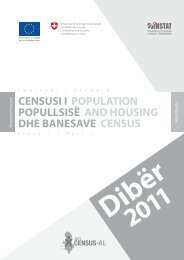Description of methods and sources for Albania - INSTAT
Description of methods and sources for Albania - INSTAT
Description of methods and sources for Albania - INSTAT
- No tags were found...
Create successful ePaper yourself
Turn your PDF publications into a flip-book with our unique Google optimized e-Paper software.
IPA 2009 Multi-beneficiary StatisticalCooperation ProgrammeIndices <strong>of</strong> volume on “retail trade” <strong>and</strong> “sale <strong>and</strong> repair <strong>of</strong> motorvehicles”Foreign tradeDeflators Balance <strong>of</strong> electric powerFrom this survey we can get data <strong>for</strong> the electric power separated by <strong>sources</strong> <strong>and</strong>users, in volume <strong>and</strong> value. Actually, <strong>for</strong> this branch <strong>of</strong> the economy we have aspecific case <strong>of</strong> investigation. We estimate this by the direct method. So the value <strong>of</strong>output is equal with the value invoiced to the consumers. To estimate the output atconstant prices, we create a volume index which is based on the total KW powerproduced in the country <strong>and</strong> the total KW power imported. This series can be used toproduce the output at constant prices. The total value <strong>of</strong> the imported KW power isconsidered as an intermediate consumption; in addition to that there is also thedomestic IC. To estimate the domestic IC we suppose that it is constant per each KWin the short run. So, from the latest annual data where we have a domestic IC we finda ratio <strong>of</strong> IC per KW which we use to estimate the current domestic IC. In this waywe estimate the total IC as a sum <strong>of</strong> both. For the deflating IC, we create a priceindex from the imports to deflate the import part, <strong>and</strong> <strong>for</strong> the domestic part we createan index from the IC/KW series. All data needed above are available nearly 70-80days after the quarter has finished. For a detailed description <strong>of</strong> data collected fromthe balance <strong>of</strong> electric power, see Annex H Tab H.1. Short term statisticsThis survey covers some <strong>of</strong> the economic branches such as: industries, construction,trade, hotel, transport <strong>and</strong> communication. Volume <strong>and</strong> value data based on quarterlyfrequencies are collected in the survey. For a detailed description <strong>of</strong> the collecteddata, see the Annex H, Tab H.2 – Tab H.5. Indices <strong>of</strong> volume on “retail trade” <strong>and</strong> “sale <strong>and</strong> repair <strong>of</strong> motor vehicles”In this survey, we have collected some data such as those <strong>of</strong> non-specialized storewith food, beverages, tobacco, total sale <strong>and</strong> repair <strong>of</strong> motor vehicles, etc, which arebased on the “NACE 4” classification. For a detailed description <strong>of</strong> data collected seethe Annex H, Tab H.6. Foreign tradeThe data related to the <strong>for</strong>eign trade comes from the General Customs Directoratewhich is based on the Combined Nomenclature classification. These are grouped bycountries where they are imported from or exported to. This data has a monthlyfrequency <strong>of</strong> collections. In general, we use some <strong>of</strong> this data to create the volumeindexes in comparison with the data coming from other <strong>sources</strong>, or in the case <strong>of</strong>electricity, in order to estimate the electricity imported <strong>and</strong> exported <strong>for</strong> each month.Deflators160/236



